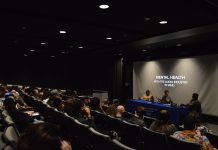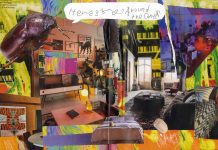Using nature as the subject of art, Earth Works is the Cecille R. Hunt Gallery’s latest exhibition.
The exhibition had its opening ceremony on April 8 and was curated by Jeff Hughes, professor of art history & criticism, as well as the director of the Hunt Gallery. He said the inspiration for this show came from a want to celebrate Earth Day and a wish to incorporate the late artist Robert Smithson’s work on environmental photography.
Hughes said the show is called Earth Works to support the view that “even in the worst of situations, the Earth is still working.”
According to a post on the Hunt Gallery’s Facebook page, this exhibition “will highlight recent artists who are using the environment as image or material rather than the subjects of manipulation of earth or necessarily environmental impact/devastation.”
“[It’s] artworks that are about nature, but not necessarily directly about the cataclysmic issues with the environment right now. Although they might touch on that, but they might also look at nature as a positive force,” Hughes said. “What Earth Works tries to show is that it’s possible to understand the Earth as a positive ecosystem, as well as the ecosystem that humans are destroying. We know what’s going to happen to humans. But the Earth is just dealing, right? So the Earth will work.”
The works include paintings, drawings, photographs and videos. Artists whose work is shown in this exhibition are Janaina Tschäpe, Cristina Molina, John Ruppert, Kim Anderson, Molly Segel and Abbey Hepner.
The artists participating in this showing originate from across the United States, from California to Louisiana to Illinois to Florida to Maryland to New York. Hughes said that, additionally, the Gallery hosts at least one show a year with an international component, bringing in recent art from artists across seas.
Hughes said the Gallery always strives to show art that is socially relevant.
“The goal of the Hunt Gallery is to show contemporary work that is meaningful (conceptually, aesthetically and socially) to the broader St. Louis community. It’s primarily part of the teaching mission of the Department of Art, Design and Art History,” Hughes said. “So it’s there for our students and for our bigger Webster community to interact with contemporary art, but then also as part of the broader cultural fabric of St. Louis.”
Two years ago in April, Hughes wanted to host an environmental artwork show to commemorate the 50th anniversary of Earth Day, but the onset of the COVID-19 pandemic disrupted plans for the in-person Gallery showings.
Now, Hughes put together the Earth Works exhibition, which takes influences from Robert Smithson’s environmental photography from the 1970.
“[Smithson] was significant in creating what was called a land art movement, to quite literally manipulate land or areas as art material. He called those ‘earthworks,’” Hughes said.
As part of Smithson’s project, he visited Paterson, New Jersey and took photographs of sites with dilapidated buildings, pouring of sewage and other industrial runoff being dumped into the waters nearby.
“He goes and he begins to look at places where there’s industrial horrors, really. And he began to record this photographically. And he called them monuments,” Hughes said. “A monument focuses our attention, it makes us think about something from the past – to make us reflect. That’s what a monument does. And Smithson was really making people reflect on these places where there was industrial waste or where a former beautiful building had gone into disrepair.”
After seeing these industrial sites, Smithson subsequently worked to turn leftover earth, rock, glass and metal into what he called “non-sites,” assembling the materials into sculptures at his gallery.
Hughes said what he hopes the newest exhibition brings to the Webster community is inspiration for students to think about and discuss how visual art and social issues can be correlated.
“I think more broadly, I’d like it to start a dialogue,” Hughes said. “I hope that there could be a dialogue that would be instigated that would see, you know, what can happen [by] painting a small painting, taking a photograph? Or just talking about it, what can people do?”
Earth Works will be available for public viewing until May 13, 2022.
Share this post
Kate McCracken (she/her) is currently a staff writer for The Journal. She has previously worked as the lifestyle editor. She is a double major in Philosophy and History, minoring in Professional Writing. She has always loved to write and create stories, and she wrote her first book at age 10. Aside from writing, Kate also enjoys photography, environmental/animal activism, paranormal investigation and oneirology, the study of dreams.




